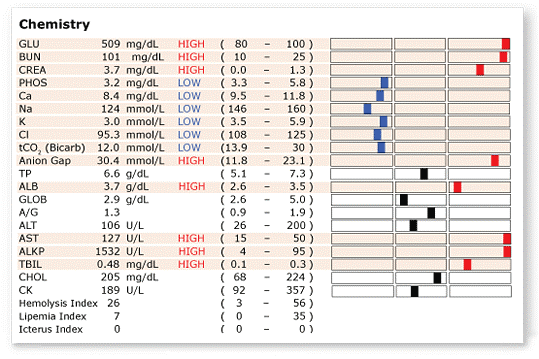Insulin and Diabetes Mellitus: Clinical Case Study
Insulin and Diabetes Mellitus |
HPI: JJ, a 12-year-old boy, is brought into your office by his mother, who is concerned that he has to go to the bathroom “all the time”. She says that he has been drinking and urinating much more than normal for the past few weeks and has recently complained of generalized abdominal pain. He is nauseated and unable to keep any food down. He vomited once last night and twice this morning. PMI: JJ was hospitalized following a car accident when he was 7. He suffered a fractured clavicle and was kept overnight for observation.He has had no further medical problems and is not on any medications. P/E: Unwell-appearing young boy mild respiratory distress. Vitals: HR110; RR 24; BP 102/60 mm Hg; T 36.7°C (98°F); SpO2 97% on room air. Head and neck exam is unremarkable, except for a fruity smell to his breath. Cardiovascular exam reveals a rapid, thin heart rate and cool extremities. Respiratory exam reveals elevation respirations, but good air entry is heard to the bases bilaterally and there are no abnormal sounds. Abdominal exam reveals a soft abdomen with normal bowel sounds. There is no evidence of hepatosplenomegaly, guarding, or rigidity. Investigation: You order a chemistry panel for JJ (see Figure 1). |

Figure 1 |
| Question | Your Answer |
What is the most likely diagnosis of this patient? |
Diabetic ketoacidosis (DKA) |
Which organ is primarily involved in this condition and what is the underlying problem? |
The pancreatic beta cells produce insulin that, when distributed throughout the body in the blood, allow glucose to enter cells. In type I diabetes mellitus (DM), the pancreatic acinar cells are destroyed by an autoimmune-like reaction and no longer produce glucose. |
Why is his respiration rate so high? |
Without glucose to metabolize for energy, cells switch to anaerobic metabolism, the end product of which is lactic acid. A build-up of lactic acid creates a state of metabolic acidosis. In an attempt to compensate, the lungs increase their rate, thereby blowing-off CO2 to create a respiratory alkalosis. |
Why is he drinking and urinating so much? |
In type-I DM, the increase in blood sugar reaches a point where the kidneys can no longer reabsorb it all from the filtrate, and glucose begins passing through the tubules into the urine. Along with it, glucose attracts water, increasing the amount of urine formed. This creates a state of dehydration that increases thirst. |
What are good screening tests for this condition? |
Serum glucose concentrations (“blood sugar”) and a urinalysis are good screening tests. While serum glucose fluctuates during the day and is therefore best measured following a period of fasting, finding glucose in the urine is always unusual and should prompt further investigations. |